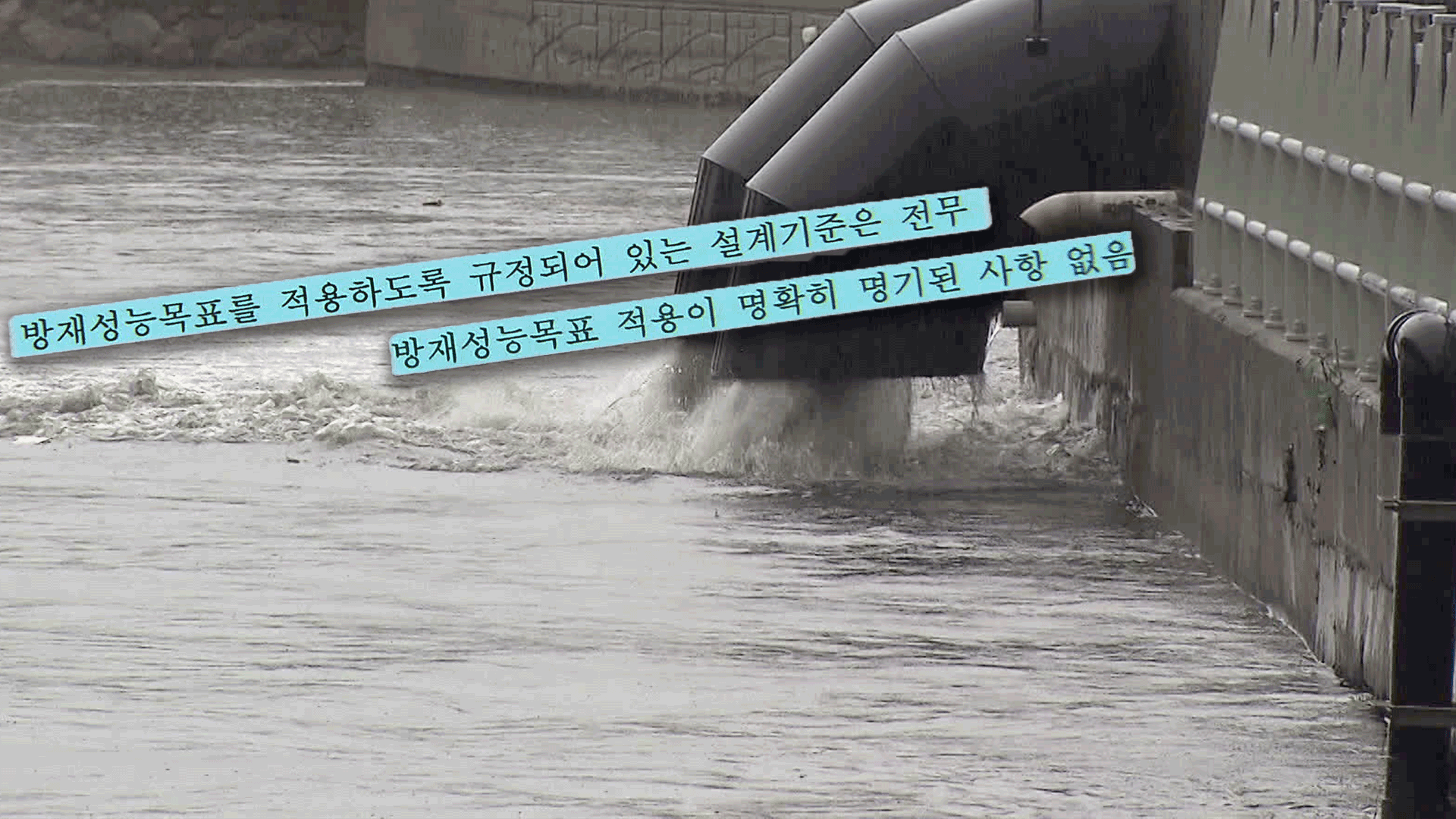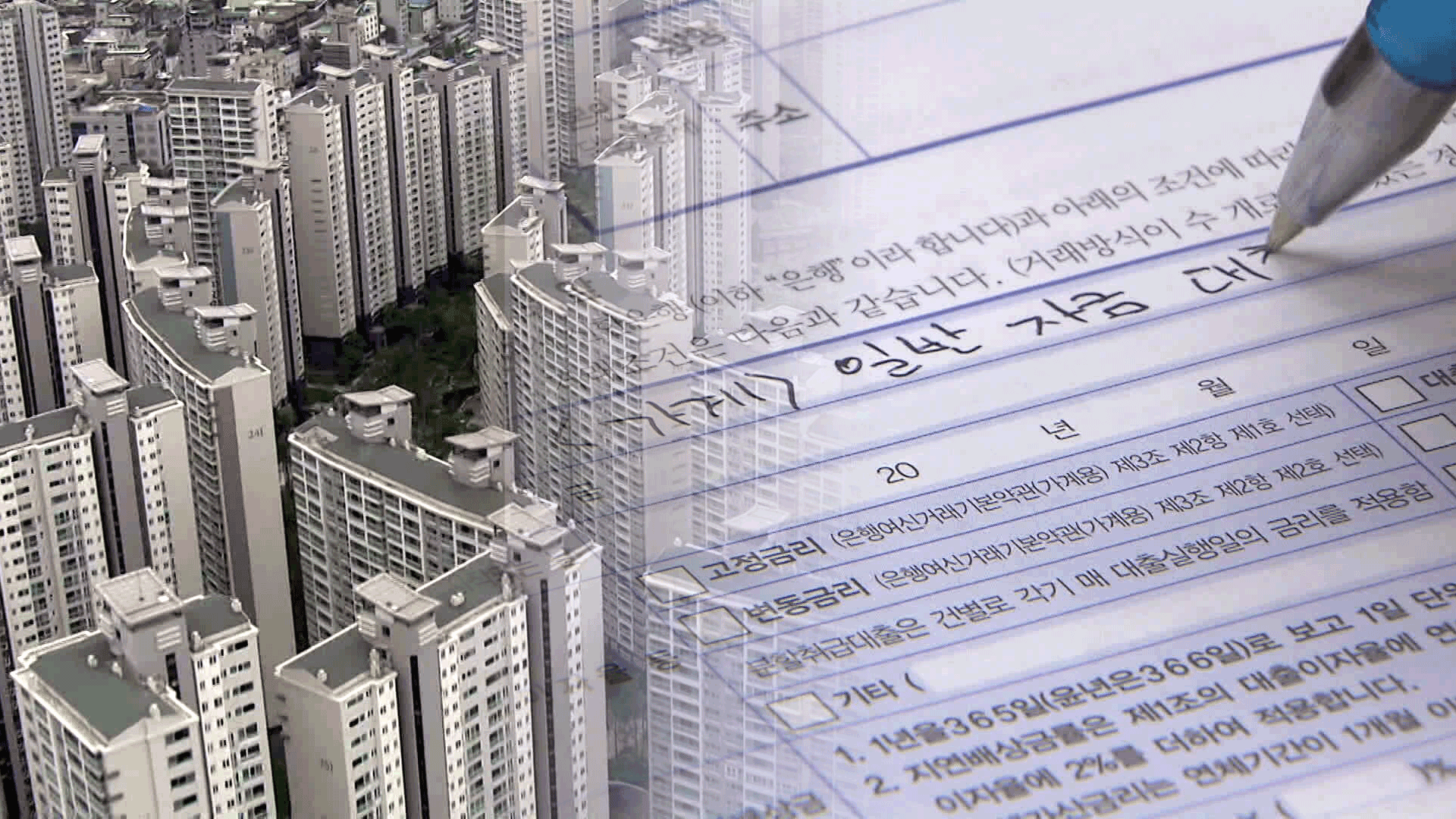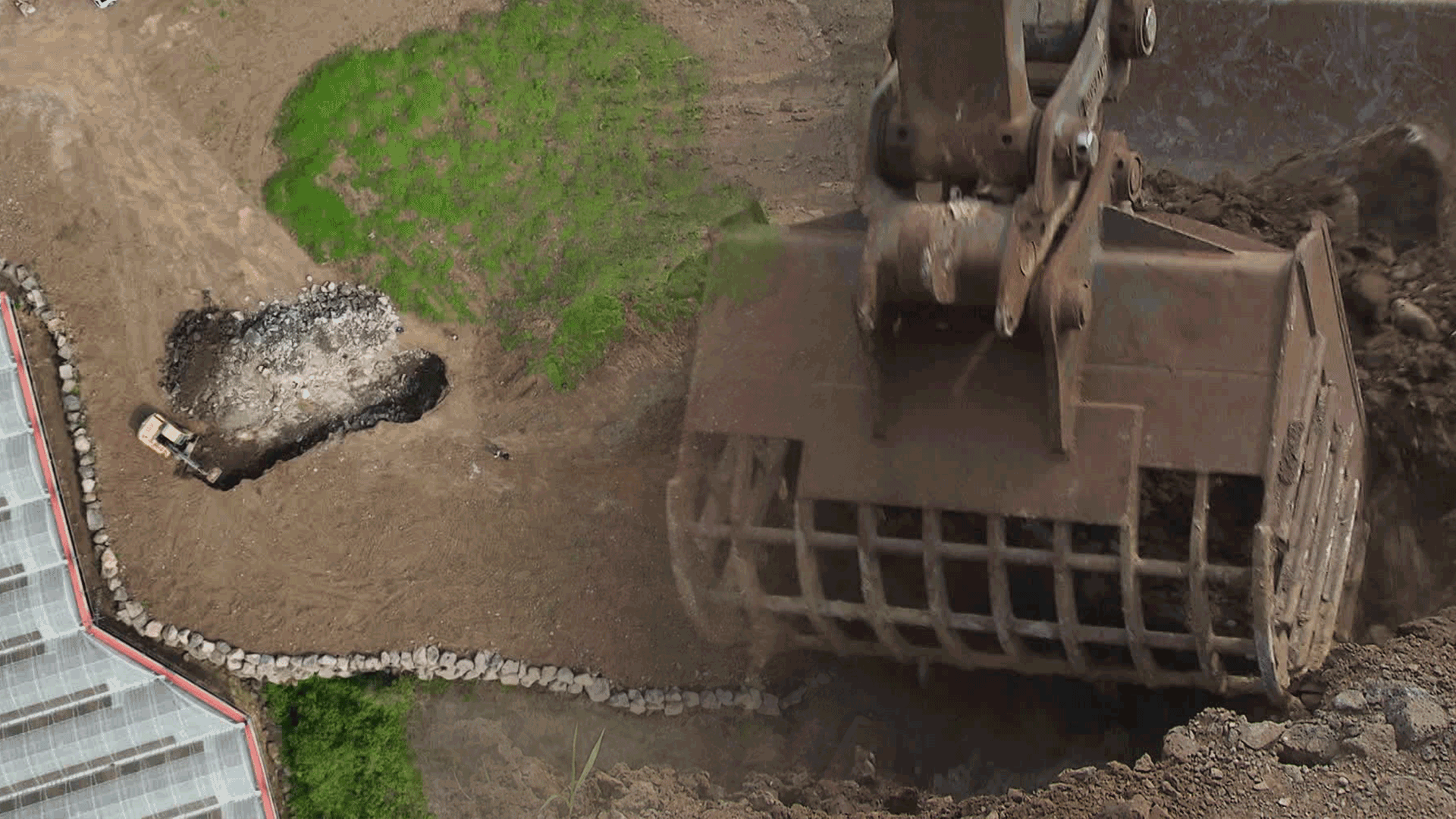Unchecked disaster prevention systems
입력 2025.06.28 (01:04)
읽어주기 기능은 크롬기반의
브라우저에서만 사용하실 수 있습니다.
[Anchor]
In South Korea, the impact of climate change has been causing damage for some time now.
In particular, as extreme rainfall has continued, the government has mandated that the performance of disaster prevention facilities must be maintained above a certain level by law.
However, it has been revealed that for over 10 years, this has only remained a relief effort without any specific guidelines.
Reporter Lee Seul-ki has the exclusive report.
[Report]
This is a rainwater pumping station prepared for the flooding of the Han River.
As a disaster prevention facility, this place has performance goals set according to the Natural Disaster Countermeasures Act.
It must be able to respond to extreme rainfall that occurs once every 50 years.
Can these disaster prevention facilities actually withstand extreme rainfall?
Through a request for information disclosure, it was confirmed that since the relevant legislation was created in 2012, there has been only one evaluation of disaster prevention performance in Seoul and six major cities.
[A local government official/voice altered: "We have not conducted a separate evaluation of disaster prevention facilities."]
[B local government official/voice altered: "This is the first time I've heard about disaster prevention performance."]
There are only goals set, but there are no specific guidelines to achieve those goals, meaning there are no standards for what conditions must be met to withstand 50-year frequency heavy rainfall.
In the case of rainwater pumping stations, the Sewage Act stipulates that they must withstand heavy rainfall with a frequency of once every 30 years, indicating a lack of consistency among laws.
A report obtained by KBS from the Ministry of the Interior and Safety also points out that there are no design standards to achieve disaster performance goals, and the relevant regulations are unclear.
[Kim Byeong-sik/Professor/Graduate School of Disaster Prevention, Gangwon University: "(For heavy rainfall) there are design frequencies, but the values of disaster performance goals are not reflected there. There are no detailed guidelines, so there are no unit prices. Unit prices are the basis for providing funding. Performance improvements will cost money, right? That budget is not available to local governments."]
The Ministry of the Interior and Safety explained that there are many cases where facility standards differ by department and that they plan to create unified standards.
In the past five years, property damage due to heavy rainfall has totaled over 2.3 trillion won, more than six times the damage amount from the previous five years.
This is KBS News, Lee Seul-ki.
In South Korea, the impact of climate change has been causing damage for some time now.
In particular, as extreme rainfall has continued, the government has mandated that the performance of disaster prevention facilities must be maintained above a certain level by law.
However, it has been revealed that for over 10 years, this has only remained a relief effort without any specific guidelines.
Reporter Lee Seul-ki has the exclusive report.
[Report]
This is a rainwater pumping station prepared for the flooding of the Han River.
As a disaster prevention facility, this place has performance goals set according to the Natural Disaster Countermeasures Act.
It must be able to respond to extreme rainfall that occurs once every 50 years.
Can these disaster prevention facilities actually withstand extreme rainfall?
Through a request for information disclosure, it was confirmed that since the relevant legislation was created in 2012, there has been only one evaluation of disaster prevention performance in Seoul and six major cities.
[A local government official/voice altered: "We have not conducted a separate evaluation of disaster prevention facilities."]
[B local government official/voice altered: "This is the first time I've heard about disaster prevention performance."]
There are only goals set, but there are no specific guidelines to achieve those goals, meaning there are no standards for what conditions must be met to withstand 50-year frequency heavy rainfall.
In the case of rainwater pumping stations, the Sewage Act stipulates that they must withstand heavy rainfall with a frequency of once every 30 years, indicating a lack of consistency among laws.
A report obtained by KBS from the Ministry of the Interior and Safety also points out that there are no design standards to achieve disaster performance goals, and the relevant regulations are unclear.
[Kim Byeong-sik/Professor/Graduate School of Disaster Prevention, Gangwon University: "(For heavy rainfall) there are design frequencies, but the values of disaster performance goals are not reflected there. There are no detailed guidelines, so there are no unit prices. Unit prices are the basis for providing funding. Performance improvements will cost money, right? That budget is not available to local governments."]
The Ministry of the Interior and Safety explained that there are many cases where facility standards differ by department and that they plan to create unified standards.
In the past five years, property damage due to heavy rainfall has totaled over 2.3 trillion won, more than six times the damage amount from the previous five years.
This is KBS News, Lee Seul-ki.
■ 제보하기
▷ 카카오톡 : 'KBS제보' 검색, 채널 추가
▷ 전화 : 02-781-1234, 4444
▷ 이메일 : kbs1234@kbs.co.kr
▷ 유튜브, 네이버, 카카오에서도 KBS뉴스를 구독해주세요!
- Unchecked disaster prevention systems
-
- 입력 2025-06-28 01:04:49

[Anchor]
In South Korea, the impact of climate change has been causing damage for some time now.
In particular, as extreme rainfall has continued, the government has mandated that the performance of disaster prevention facilities must be maintained above a certain level by law.
However, it has been revealed that for over 10 years, this has only remained a relief effort without any specific guidelines.
Reporter Lee Seul-ki has the exclusive report.
[Report]
This is a rainwater pumping station prepared for the flooding of the Han River.
As a disaster prevention facility, this place has performance goals set according to the Natural Disaster Countermeasures Act.
It must be able to respond to extreme rainfall that occurs once every 50 years.
Can these disaster prevention facilities actually withstand extreme rainfall?
Through a request for information disclosure, it was confirmed that since the relevant legislation was created in 2012, there has been only one evaluation of disaster prevention performance in Seoul and six major cities.
[A local government official/voice altered: "We have not conducted a separate evaluation of disaster prevention facilities."]
[B local government official/voice altered: "This is the first time I've heard about disaster prevention performance."]
There are only goals set, but there are no specific guidelines to achieve those goals, meaning there are no standards for what conditions must be met to withstand 50-year frequency heavy rainfall.
In the case of rainwater pumping stations, the Sewage Act stipulates that they must withstand heavy rainfall with a frequency of once every 30 years, indicating a lack of consistency among laws.
A report obtained by KBS from the Ministry of the Interior and Safety also points out that there are no design standards to achieve disaster performance goals, and the relevant regulations are unclear.
[Kim Byeong-sik/Professor/Graduate School of Disaster Prevention, Gangwon University: "(For heavy rainfall) there are design frequencies, but the values of disaster performance goals are not reflected there. There are no detailed guidelines, so there are no unit prices. Unit prices are the basis for providing funding. Performance improvements will cost money, right? That budget is not available to local governments."]
The Ministry of the Interior and Safety explained that there are many cases where facility standards differ by department and that they plan to create unified standards.
In the past five years, property damage due to heavy rainfall has totaled over 2.3 trillion won, more than six times the damage amount from the previous five years.
This is KBS News, Lee Seul-ki.
In South Korea, the impact of climate change has been causing damage for some time now.
In particular, as extreme rainfall has continued, the government has mandated that the performance of disaster prevention facilities must be maintained above a certain level by law.
However, it has been revealed that for over 10 years, this has only remained a relief effort without any specific guidelines.
Reporter Lee Seul-ki has the exclusive report.
[Report]
This is a rainwater pumping station prepared for the flooding of the Han River.
As a disaster prevention facility, this place has performance goals set according to the Natural Disaster Countermeasures Act.
It must be able to respond to extreme rainfall that occurs once every 50 years.
Can these disaster prevention facilities actually withstand extreme rainfall?
Through a request for information disclosure, it was confirmed that since the relevant legislation was created in 2012, there has been only one evaluation of disaster prevention performance in Seoul and six major cities.
[A local government official/voice altered: "We have not conducted a separate evaluation of disaster prevention facilities."]
[B local government official/voice altered: "This is the first time I've heard about disaster prevention performance."]
There are only goals set, but there are no specific guidelines to achieve those goals, meaning there are no standards for what conditions must be met to withstand 50-year frequency heavy rainfall.
In the case of rainwater pumping stations, the Sewage Act stipulates that they must withstand heavy rainfall with a frequency of once every 30 years, indicating a lack of consistency among laws.
A report obtained by KBS from the Ministry of the Interior and Safety also points out that there are no design standards to achieve disaster performance goals, and the relevant regulations are unclear.
[Kim Byeong-sik/Professor/Graduate School of Disaster Prevention, Gangwon University: "(For heavy rainfall) there are design frequencies, but the values of disaster performance goals are not reflected there. There are no detailed guidelines, so there are no unit prices. Unit prices are the basis for providing funding. Performance improvements will cost money, right? That budget is not available to local governments."]
The Ministry of the Interior and Safety explained that there are many cases where facility standards differ by department and that they plan to create unified standards.
In the past five years, property damage due to heavy rainfall has totaled over 2.3 trillion won, more than six times the damage amount from the previous five years.
This is KBS News, Lee Seul-ki.
-
-

이슬기 기자 wakeup@kbs.co.kr
이슬기 기자의 기사 모음
-
이 기사가 좋으셨다면
-
좋아요
0
-
응원해요
0
-
후속 원해요
0















이 기사에 대한 의견을 남겨주세요.